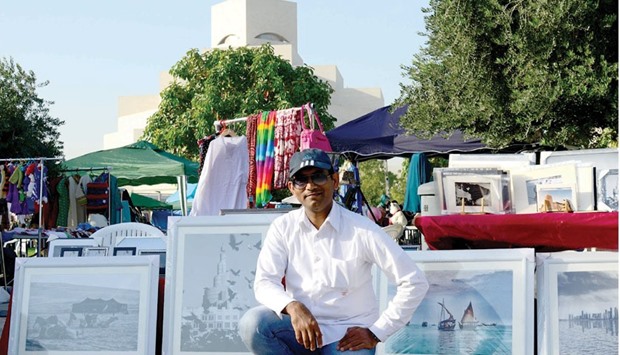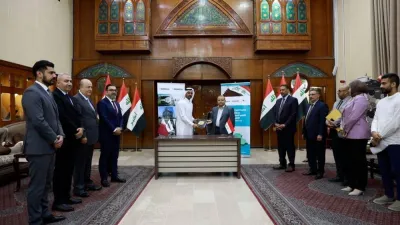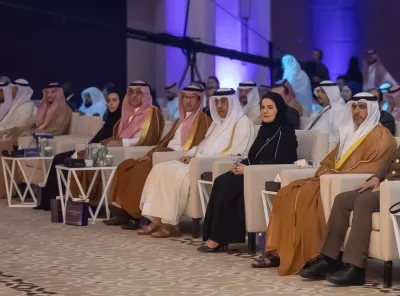In the vast market-scape of the Museum of Islamic Art (MIA) Park Bazaar that buzzes with frenetic activity on Saturdays, local photographer Kaleem Ahmed’s stall stands out for its showcasing of the quintessential Qatar.
Overrun with large frames and prints, Indian expat Ahmed’s booth boasts of a wide sweep of visuals that encapsulate the many charms and moods of the nation for more than a decade. “My photos are focused on Qatari culture and visuals that speak of Qatar and its uniqueness,” Ahmed says.
Mosques, camels, falcons, sandscapes, dhows, swords, the Arabian Gulf and the glittering Doha skyline, mostly make for his visual fascinations. Ahmed is one of those few who set up his stall at the MIA Park Bazaar, a refreshing modern version of the old Souq tradition, ever since it started around three years ago and is still going strong. “In fact, I have expanded my stall over time,” he says, “I started off with just one table and around 15 photographs. Then it became bigger as I kept adding more elements to it over the weeks.”
Every year, from October to April, when the weather in Qatar gets pleasant, the MIA Park Bazaar blooms – it used to spring up only on the first Saturday of every month but has now become a fixture every Saturday – with more than 150 stalls that sell everything from clothes, jewellery, books, art, crafts, and knick-knacks, to food. Like it has been for many, for Ahmed, too, the Bazaar has been a wonderful platform to put his work out there and interact with the community at large.
For Ahmed, who has been in Doha for nearly two decades now, it all started around 15 years ago when he bought a manual camera. “I would take pictures of my friends – we were a group of 25 people – and both the results and their response encouraged me,” he recalls, “We would often visit the Corniche and I would always be that guy taking pictures. I think I always had the eye for photography.”
The photography bug had well and truly bitten Ahmed. “The thrill of printing my pictures would keep me guessing. In the dark room, I would watch the images come alive,” he says, adding that his only training was a one-month course he took at VCU-Q, which helped him grasp the basics. With time, Ahmed switched to DSLRs with ease.
“I started off taking portraits but I found my groove in capturing landscapes and architecture; be it of deserts or the many masjids of Doha or the beautiful MIA building. I like to photograph elements of nature, like the open desert or the sea, which, to me, symbolise relaxation,” he says.
When the renovated Souq Waqif was reopened, Ahmed spent four hours snapping up its pictures from varied perspectives and with new eyes. “I was surprised by myself when I saw the results on the computer,” he says, and points to some of those pictures that are now on display at his stall.
Photography has always been a passion and not a business, he insists. “The most important aspect of setting up this stall has been the feedback. The response is amazing,” says Ahmed, who works as an assistant to a top photographer, “Many appreciate, some criticise, and I accept it all.”
One of his photographs, a panoramic shot of the Doha skyline features an overtly pronounced reflection of the buildings in the sea. “I have been told that these shadows are too sharp, and I agree. The next time around, I’ll soften them up,” he says, smiling, “Also, I like to shoot in black and white. It brings some kind of mystery, which makes the viewer want to know more and even want to visit that exact place.”
A vertical shot of the Fanaar, filled with fluttering pigeons in the foreground, which won him a photography award on Qatar National Day 2010, is among those eye-catching ones that usually compel a visitor to initiate a conversation. “I spend my Saturday here and I feel relaxed,” Ahmed says, “I get to meet different kind of people and it’s interesting to see how they view the image in entirely different ways.”
“You come to know something about people and photography that you didn’t know before,” Ahmed continues, pointing to a picture of the Souq Waqif mosque, “Many visitors, for instance, keep looking at this one and make guesses such as Oman and Dubai, and I tell them – No, it’s in Doha. I then explain to them that I was inside the mosque when I took this picture. As it had just rained, the gentle colours of the courtyard are infused with a magical reflection. It is savouring and capturing such moments that give me satisfaction.”

CLICK ON: Kaleem Ahmed at his stall in the MIA Park Bazaar. Photographs by Anand Holla


